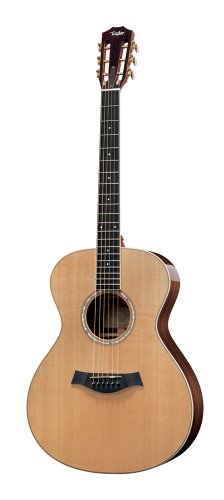Taylor Guitars GC7 Grand Concert Acoustic Guitar Review

See more picture

Taylor Guitars GC7 Grand Concert Acoustic Guitar Feature
- Solid Cedar Top
- Solid Mahogany Back/Sides
- Grand Concert
- Hardshell Case Included
The GC7 is intimate and curvy yet with volume that belies its size. The slotted peghead and short-scale neck deliver a more "woody" tone and an unbelievably easy feel on the fretboard. A cedar top adds a mellow warmth to rosewood’s big, bold tone, while an elegant slotted peghead adds even more to the acoustic experience.
 | - 6-String Grand Concert body
- Western red cedar top
- Indian rosewood back and sides
- Abalone soundhole rosette and fretboard inlays
- Ebony fretboard and bridge
- Tusq nut and saddle
- Taylor slot-head tuners
- Adjustable truss rode
- Strung with Elixir Light Gauge Strings with NANOWEB Coating
|
|  |
|
Taylor's Grand Concert Shape
Because of its smaller size, Taylor's Grand Concert traditionally has been a comfortable, "intimate" guitar--something to wrap oneself around. Its clarity, balanced response, scaled-down proportions, and scalloped bracing make it ideal for fingerstyle. Stage performers appreciate its body-friendly size and contours, and those who work in the recording studio love its controlled overtones. In 2000, Taylor re-designed the Grand Concert to bring it more in line with the other Bob Taylor originals, and then in 2004 they expanded its body depth by a quarter-inch and revoiced it to add volume and bass response giving it a tone that belies its size.
 Features Taylor's Grand Concert body shape. Features Taylor's Grand Concert body shape. |
Classic Wood Combination
The top is made from western red cedar, which has been used for decades as a soundboard material on classical guitars. Cedar is a "soft" wood known for producing a "warm," mellow tone. Its overtones are evenly distributed, rather than concentrated on the highs and lows, making it especially suitable for fingerstyle playing. Cedars light brown color also lends a guitar a visual warmth that many players find appealing.
The back and sides are made from Indian rosewood, which is coveted by players and guitar builders alike for its dark, luxurious coloration that ranges from brown to purple to rose to black, and for tonal characteristics that include a strong bass response and long sustain. It remains the most popular tonewood used in the making of high-quality acoustic guitars.
In short, the distinctive blend of big leaf maple and sitka spruce gives the GC7 a bright, crystaline timbre with strong projection and warm overtones. It's a combination that truly "cuts through."
 Solid western red cedar top is joined with Indian rosewood back and sides for a bright, crystaline timbre with strong projection and warm overtones. Solid western red cedar top is joined with Indian rosewood back and sides for a bright, crystaline timbre with strong projection and warm overtones. |
Construction
Taylor takes pride in using the finest quality woods for their guitars, like ebony for every fretboard they make. The tone woods for the GC7 were quartersawn and carefully book-matched before being sorted, dried, and prepared by Bob Taylor and his experienced team of luthiers. The GC7 abalone inlay and binding work was also done by hand, providing care and "touch" that no machine can give. Taylor believes that precision matters, which is why they rely on laser cutters and computer-aided milling machines to consistently hit minute tolerances that were impossible a decade ago.
Balance and Bracing
A balanced tone is critical to a quality recorded sound. Guitars that are too heavily weighted towards a particular end of the tonal spectrum (too "bassy," for example) tend to be tougher to record. While the Dreadnought shape has more volume or bass than other shapes, the overall balance on the GC7 is not compromised.
 Features abalone dot inlays. Features abalone dot inlays. |
Straight Necks Matter
Don't all guitars have straight necks? The answer is usually yes, but the real question is will they stay that way? Since its inception, the acoustic guitar had a major design flaw. The fretboard lacked sufficient support to remain truly straight because of top movement caused by changes in humidity. All guitars experience this phenomenon--often resulting in a slight bump at the 14th fret--but not all guitars respond to it in the same way.
Introduced in 1999 and a standard feature since 2001, the patented New Technology (NT) neck was designed by Bob Taylor and his team to accomplish the primary goal of building a straighter, more stable guitar neck. While some necks may bend in the face of humidity and other factors, the NT Neck stays stable and straight.
Adjustability is another major NT advantage. Since the NT Neck angle is created by spacers and requires no glue, adjustment simply requires a repair person with a new set of spacers and about five spare minutes. Altering the neck angle of a traditional neck assembly could require invasive surgery to remove wood and relocate the bridge.
The bottom line: The NT Neck on the GC7 means a stable, easy-to-adjust neck that stands up to the pressures all acoustic guitars face.
Tuners
Precise, gleaming tuners add appealing form to an important function, while the type of strings used can alter the feel and the tone of your guitar. Taylor pays careful attention to both, using tuners and strings that are optimized for the GC7 guitar. Together, they are among the keys to an easy-playing, incredible-sounding Taylor.

Check price now
Sep 18, 2011 13:30:35




















